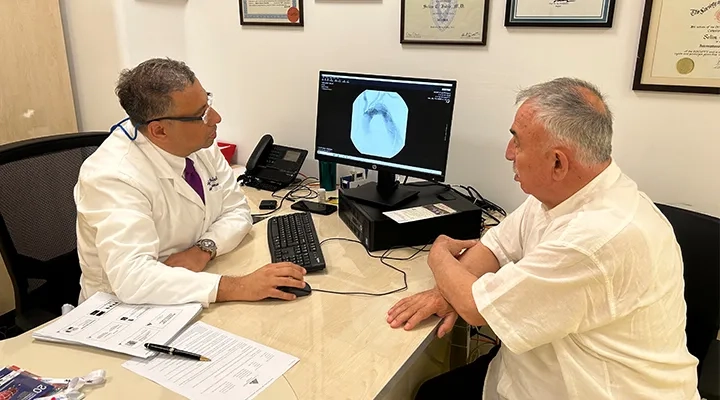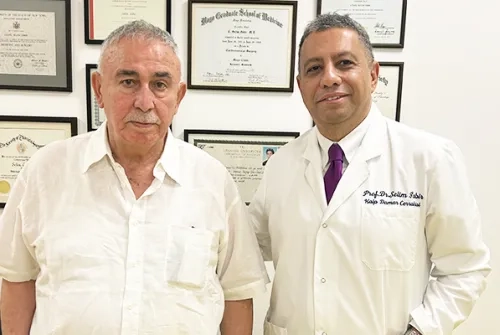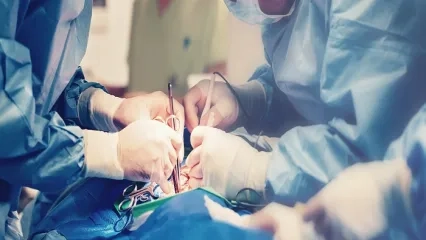Alo Yeditepe
Alo Yeditepe
He Went to the Hospital with Leg Pain, Discovered His Carotid Artery Was 95% Blocked
Seven years ago, 70-year-old Hüseyin Toplusoy underwent surgery due to an aortic aneurysm. Despite continuing to smoke and neglecting his check-ups during this period, Toplusoy visited the hospital for leg pain only to learn that his carotid artery was 95% blocked and he was at high risk for a stroke, alongside the aneurysm in his chest. Cardiovascular Surgery Specialist Prof. Dr. Selim İsbir explained that the patient was facing a life-threatening situation with both a stroke and a serious aneurysm rupture and was brought back from the brink of death with three different surgeries. Prof. Dr. Selim İsbir emphasized that patients with arteriosclerosis should not fall into the misconception that everything is resolved after one surgery, as in this example. He stated, “Patients must remember that if they continue to maintain the same risk factors in their lives after surgery for diseases related to arteriosclerosis, the disease may recur.”
Arteriosclerosis: The Leading Cause of Death in Cardiovascular Diseases
Prof. Dr. Selim İsbir from Yeditepe University Koşuyolu Hospital, an expert in Cardiovascular Surgery, highlighted the severity of arteriosclerosis and stated that it is the leading cause of death in cardiovascular diseases in our country. “Smoking is one of the most significant reasons for the development of the disease. Arteriosclerosis can affect all arteries. One of the most common areas we encounter is carotid artery involvement. Another frequent issue is the ballooning condition called aortic aneurysm in the aorta. This is a very serious disease that results in the dilation and rupture of the artery after it reaches a certain diameter. If a patient has arteriosclerosis and it affects one artery, all other arteries can also be affected. For instance, someone who has a heart attack might simultaneously have carotid artery involvement, aortic aneurysm, or leg artery blockages. Therefore, patients should also be evaluated from this perspective,” he explained
The Patient Faced Both Stroke and Serious Aneurysm Rupture
Prof. Dr. İsbir emphasized that Yusuf Toplusoy had been treated years ago for aortic dilation but had reduced his follow-up check-ups. “He came to us because the aneurysm in his abdominal area was also detected in his chest. We simultaneously checked the patient’s carotid arteries and found a 95% narrowing. We treated the patient’s carotid artery first and then his chest aneurysm,” he said. Prof. Dr. İsbir explained that the patient had a 95% blockage in his carotid artery and was at high risk of stroke. “The aorta was exceeding 6 centimeters. The patient was facing a life-threatening risk of both stroke and a severe aneurysm rupture. Our patient had neglected necessary follow-ups. He continued smoking after his initial surgery, and his disease progressed. Patients like Yusuf Bey should not fall into the misconception that ‘everything is over’ after surgery for arteriosclerosis. If they continue with situations maintaining risk factors, they might face the 234th surgery,” he stated

Carotid Artery Blockages Can Lead to Stroke
Highlighting the importance of carotid artery blockages due to their risk of resulting in stroke, Prof. Dr. İsbir continued, “However, it should also be noted that with preventive measures, stroke can be a preventable disease. Vascular diseases are systemic. Early treatment yields more successful results. Especially those who are older, smoke, have high blood pressure, high blood lipids, and a family history of arteriosclerosis should definitely not neglect their check-ups. If early diagnosis is not achieved, deaths related to cardiovascular diseases will continue to increase.”
My Doctor Saved Me from a Stroke
Yusuf Toplusoy, who went to the hospital with pain in his left leg, shared his experience: “When I was told at the hospital that my aorta had ballooned and I needed to go to the cardiovascular department immediately, I went to Dr. Selim. He requested some imaging. I’m glad he did because a 95% narrowing was found in my carotid artery. My father had also died due to this reason. Dr. Selim saved me from a stroke. First, I had surgery on my carotid artery, then on my aorta. I am very thankful to Dr. Selim and his team.”
We Can’t Change Our Genes, But We Can Quit Smoking
Toplusoy, who had surgery seven years ago and then resumed smoking, advised against smoking, saying, “Smoking is a significant cause of arteriosclerosis. I am very careful about what I eat and drink. I would even travel 200 kilometers to get eggs. Despite being very meticulous about everything, I faced death three times, and the most important reason for this was smoking. Smoking ruined my life. Heart disease patients should constantly go for check-ups and not skip their medications. I had a total of eight stents placed. My entire family had heart disease. My uncle and father died because of this, and my brother had three arteries replaced. We can’t change our genes, but we can quit smoking. We should live in smoke-free, alcohol-free, clean air. Life is beautiful and worth everything,” he said.
About
Faculty and Year of Graduation:
Istanbul University Cerrahpasa, 1991
Alo Yeditepe




